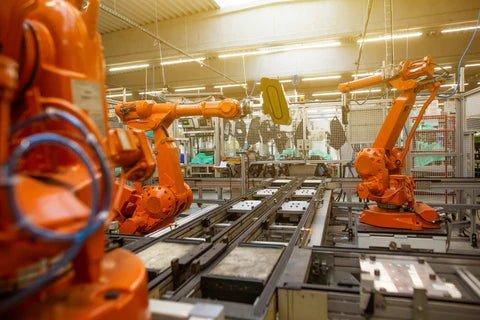The world of Artificial Intelligence (AI) is rapidly evolving, and edge computing stands out as a transformative force. By enabling AI processing closer to the data source, edge AI hardware unlocks faster decision-making, minimizes latency, and enhances privacy. But what exactly are these "edge AI accelerators" that are powering this revolution?

Edge AI accelerators are specialized hardware devices designed to speed up the execution of AI algorithms, specifically deep learning models, on edge devices. Unlike traditional processors, these accelerators are optimized for the mathematical operations used in deep learning, enabling them to perform inference (the process of using a trained model to make predictions) more efficiently. This increased speed and efficiency are crucial for applications that require real-time responses, low power consumption, and reduced latency.
To better evaluate these accelerators, we often look at a metric called TOPS (tera operations per second). A higher TOPS rating generally indicates greater theoretical performance. Alongside TOPS, developers consider compatibility with different AI frameworks, the need to compile models for a given platform, and the ability of the accelerator to function under various environmental or industrial conditions.
The need for edge AI accelerators stems from the growing demand for AI capabilities outside traditional data centers. Autonomous vehicles need to make split-second decisions from sensor data, factory robots must perform complex tasks in real-time, and smart cameras in retail stores analyze customer behavior locally. Relying on cloud processing often isn’t practical due to latency, bandwidth constraints, or privacy concerns. By providing the necessary processing power directly on the device, edge AI accelerators keep data local, enabling these use cases to thrive.
As a result, edge AI accelerators are now deployed across various industries. In automotive, they support advanced driver-assistance systems (ADAS), though it’s important to note that the full-scale autonomous driving level might require even more powerful hardware (often in the thousands of TOPS). In manufacturing, these accelerators enable predictive maintenance, quality control, and robotic automation. Smart cities use them for traffic management and environmental monitoring, while retail leverages them for personalized in-store experiences. As demand grows, the importance of edge AI accelerators will only increase.
Why Edge AI is Quietly Revolutionizing Your World
Edge AI might sound futuristic, but it’s already part of our daily interactions with technology. Imagine a world where your smartphone translates languages on the fly, your smart home adapts to your habits, and your car’s driver-assistance features respond without waiting on cloud servers. This is the power of edge AI, bringing intelligence directly to the devices at the network’s edge.
Beyond personal devices, businesses are using edge AI to streamline operations and enhance customer experiences. Consider a factory where robots and humans work side by side, guided by real-time insights that predict equipment issues before they happen. Or a retail store whose smart cameras analyze customer interactions locally, helping optimize inventory and personalize offers. Educational tools, as they evolve, may move some functionality toward edge-based models, complementing what currently often relies heavily on cloud large language models (LLMs).
For startups, edge AI can drive innovation and open new markets. Think of wearable health monitors providing immediate feedback, agricultural sensors optimizing crop yields without constant cloud connectivity, or embedded AI modules assisting in privacy-sensitive applications.
By processing data directly on devices, edge AI reduces the need to send data to the cloud—cutting down on latency, bandwidth use, and privacy risks. This local approach ensures faster responses and improved data security. As hardware and software for edge AI become more accessible, and as frameworks and communities grow, the opportunity for creating valuable, reliable, and efficient AI applications at the edge continues to expand.
In the following sections, we’ll delve deeper into two leading hardware platforms: HAILO and Coral. Understanding their strengths, limitations, and approaches will help you choose the right solution for your own edge AI projects.
Hailo - Powerhouse for High-Performance AI

When it comes to demanding edge AI applications, HAILO is a notable player. Founded in 2017 by engineers who recognized that traditional processors struggled with deep learning workloads at the edge, HAILO set out to build hardware specifically optimized for these tasks.
Their flagship product, the Hailo-8, is an AI processor that delivers a strong balance of TOPS and power efficiency. It can handle complex deep learning models on a device about the size of a credit card. This compact yet capable solution is especially appealing for power-constrained applications, such as small autonomous robots or industrial sensors.
HAILO’s solutions also cater to environments with strict standards. Some of their processors support industrial temperature ranges and automotive-grade requirements. This helps build trust for use cases like ADAS—though for full-scale autonomous driving, often requiring thousands of TOPS, more extensive setups may be needed. Nevertheless, HAILO processors are reliable building blocks for a variety of applications where real-time decision-making is critical.
From a software perspective, HAILO supports popular AI frameworks (TensorFlow, TensorFlow Lite, Keras, PyTorch, and ONNX) on both ARM and x86 systems. One important note is that models must be compiled for deployment on HAILO hardware, but HAILO provides a comprehensive toolchain to facilitate this process. This ensures that once your model is optimized for HAILO, it runs efficiently at the edge. The company has also nurtured a growing community and provides resources, giving you access to help and guidance.
While HAILO’s advanced technology comes with a higher price tag compared to some alternatives, enterprises stand to benefit from the performance and reliability it offers. You can explore their offerings here.
Coral AI - Democratizing Edge AI with User-Friendly Solutions

Coral, originally from Google AI, seeks to make edge AI accessible to everyone, from hobbyists to startups. The emphasis here is on ease of use and a welcoming environment for newcomers. Their ecosystem integrates well with TensorFlow Lite, a framework designed for mobile and embedded devices, making it straightforward to get started with common AI tasks.
A popular Coral product is the Coral USB Accelerator, which integrates the Edge TPU into existing systems via a standard USB connector. It offers a solid 4 TOPS at about 2 watts of power consumption, enabling efficient inference on moderate models like MobileNet v2. However, it’s worth noting that more recent and larger models may be more demanding, and not all features run as fast as on higher TOPS accelerators. Coral also supports an M.2 A+E key, a dual Edge TPU version with 8 TOPS total, and the widely popular Coral USB Accelerator, which is often the easiest option for adding an Edge TPU to devices like the Raspberry Pi.
When it comes to software, Coral’s integration with TensorFlow Lite makes it easy to deploy pre-trained models. There are tutorials, community forums, and a range of guides for getting started—plus existing tools like Frigate, a popular open-source NVR solution that leverages Coral for faster image processing. Do keep in mind that while Coral’s hardware is well-regarded for accessibility, long-term support and driver updates can vary. Linux support is good, but Windows support may require workarounds and may not be as seamless. Coral’s community does share tips and help, but overall update frequency from the original manufacturer has been limited in recent times.
Coral’s affordability also makes it attractive to cost-sensitive users. If you’re primarily experimenting with object detection, image classification, or keyword spotting at the edge, Coral is a solid and economical entry point. It may not offer the raw TOPS of HAILO, and customization options might be more limited, but for many use cases—such as home surveillance with Frigate or basic vision tasks—Coral gets you started quickly.
Price Comparison
| Chipset | Model | Price | TOPS | Price/TOPS |
|---|---|---|---|---|
| Hailo | Hailo-8 M.2 | €195 | 26 | €7.50 |
| Hailo | Hailo-8 Century | €739 | 104 | €7.11 |
| Hailo | Hailo-8L M.2 | €115 | 13 | €8.85 |
| Coral | Coral M.2 Accelerator | €29.61 | 4 | €7.04 |
| Coral | Coral Dev Board Micro | €79.99 | 4 | €20.00 |
| Coral | Coral Dev Board | €129.99 | 4 | €32.50 |
(Note: Prices and specifications may change over time. Consider both TOPS and the additional features, ecosystem, and development effort required.)
Which Models Work Best and When to Use Each Device?
Choosing the right accelerator often depends on the models you want to run. HAILO and Coral both support various deep learning models, but their comparative advantages differ.
Use HAILO if you need:
- High-performance object detection: HAILO performs well with computationally intensive models (e.g., complex YOLO versions), suitable for tasks like advanced driver-assistance (though large-scale autonomous driving might need significantly more TOPS), robotics, and industrial surveillance.
- Advanced image segmentation: Models like U-Net can run efficiently, enabling detailed analysis for medical imaging or satellite data.
- NLP at the Edge: Models like BERT can be run at the edge, but note that very large NLP models or LLMs might still be out of scope for these smaller accelerators.
- Multi-model and multi-stream processing: HAILO’s architecture allows simultaneous execution of multiple models and data streams.
Shop HAILO AI accelerators at buyzero.de
Use Coral if you need:
- Efficient object detection with TensorFlow Lite: Coral works well with models like MobileNet SSD v2 for tasks like people counting and basic object tracking.
- Basic image classification: Models such as Inception v3 or EfficientNet run effectively for product identification or quality checks.
- Keyword spotting and simple voice commands: Coral supports basic TensorFlow Lite audio models, suitable for straightforward keyword detection.
- Pose estimation and entry-level applications: Lightweight models like PoseNet run smoothly, enabling interactive installations or simple robotics.
Shop Coral AI accelerators at buyzero.de
Conclusion: Choosing Your Edge AI Champion
As we’ve explored, edge AI is shaping the future of technology by enabling local, real-time inference with reduced latency and enhanced privacy. Specialized hardware—edge AI accelerators—underpins this transformation.
HAILO, exemplified by the Hailo-8, shines in scenarios that demand higher performance and more complex models. Its compilation toolchain and industrial/automotive considerations make it a strong fit for certain enterprise applications that need reliable, high-quality inference at the edge.
Coral, meanwhile, focuses on accessibility, user-friendliness, and affordability. With straightforward TensorFlow Lite integration and options like the Coral USB Accelerator, it lowers the barrier to entry for hobbyists, startups, and businesses exploring edge AI for the first time. While its raw performance may not match HAILO, Coral’s ecosystem and ease-of-use are compelling for many use cases.
Ultimately, your choice between HAILO and Coral depends on your application’s complexity, performance requirements, budget, and development preferences. If you need to push advanced models and handle demanding workloads, HAILO offers more headroom. If you’re eager to experiment, prototype quickly, or implement simpler models at low cost, Coral is a practical choice.
Ready to embark on your edge AI journey? Explore our selection of HAILO and Coral products on buyzero.de and find the right accelerator for your next project.
We’d love to learn more about your project and help you select the most suitable models and accelerators. We are your navigator in the vast landscape of edge AI acceleration. Reach out to us today to discuss your requirements and let us guide you toward the optimal edge AI solution.

